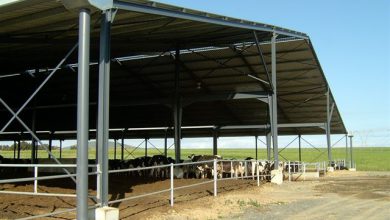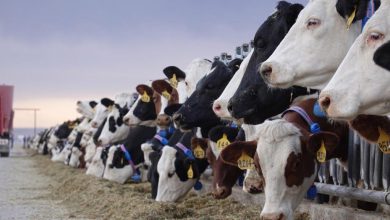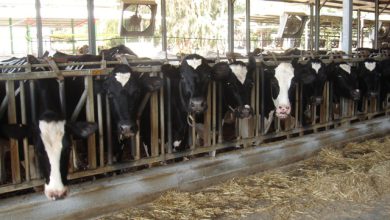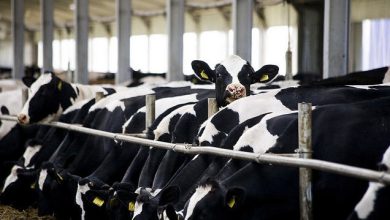The effects of summer on milk production and its components, SCC and conception rate
The "Winter-Summer Report" for the years 2007-2016
Dr. Yaniv Lavon, yaniv@icba.co.il – Israel Cattle Breeders Association (ICBA)
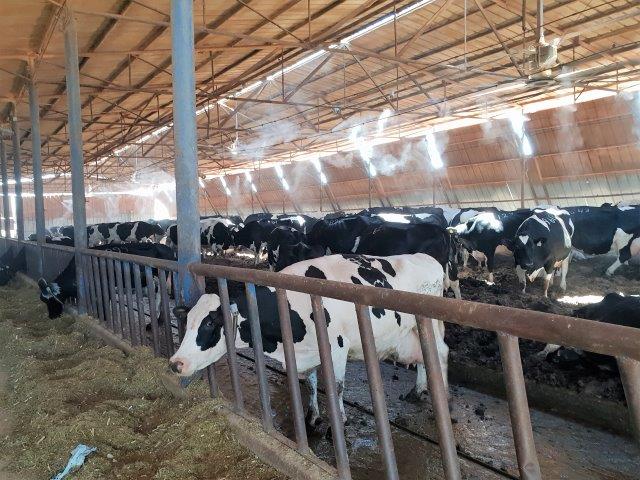

The “Winter-Summer Ratio” report was developed by the ICBA. This report reflects the gap in the performance of cows in different seasons and the ability of the individual farm to cope with the negative impact of the summer. This report includes milk production, fat and protein percentages, Somatic Cells Count (SCC), and Conception Rate to all inseminations.
For the analysis three seasons were defined: 1 – Winter (January – March), 2 – Spring (April – June), and 3 – Summer (July – September). The model includes cows with more than one milk recording per season and farms with more than 50 milk recordings per season. The variables in the model are: herd, season, herd * season, number of milking per day, gestational pregnancy status, lactation number, milking days and milking days * lactation number. In addition, another model compares the conception rates from inseminations 1 to 5 and the peak of lactation during the winter, spring and summer seasons. The ratio of summer to winter in all the variables is the dose between the corrected averages for the herd / season.
The purpose of this review is to examine whether there has been any change in the ability of the farms to cope with the heat stress during the summer season over the past 10 years as reflected in the results of the summer / winter index over the years.
The database included data for the winter summer ratio in cooperative farms from 2007 to 2016. For the joint analysis, the data were collected into one file and analyzed in SAS software. The farms were divided into three levels according to the milk ratio between the summer season and the winter season (Table 1).
Table 1: Distribution of farms to three levels according to milk production data in the summer season compared to the winter.
This distribution was used for comparison purposes in the various indices between dairy farms with high and low ratios. In this context, it is important to note that this distribution may be biased due to the differences in milk production in the summer and the possibility that farms with low summer production will have a high ratio due to low winter production and lacking a proper cooling management during the summer. For testing this problem dairy farms were divided into three levels of production. Table 2 presents the distribution of dairy farms according to production level during the summer season and shows the average ratio at each production level. It can be clearly seen that farms with high summer production levels are also likely to have high summer / winter ratios.
Table 2: Linkage between average summer production and the production ratio between summer and winter seasons throughout the period.
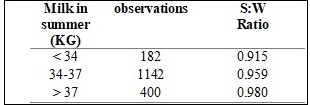
Figures 1 through 3 show data at the national level throughout the period without reference to the division described in Table 1.
Figure 1: Summer/ Winter milk ratio throughout the period (2007-2016)
.jpg)
Figure 1 describes the milk ratio between the winter months and the summer months over the years. According to the results, it is impossible to notice any improvement in coping with the summer heat stress over the years. According to Figure 1, there are significant differences between years in which the summer season was particularly warm, such as summer 2010, 2012 and 2015, compared to other years in which the summer was less warm. These findings indicate that in summers with extreme heat stress, the existing cooling systems do not allow high production, in contrast to less severe summers where the cooling systems allow better coping, which is expressed at a high level of production, not far from the winter season.
Figure 2: Average summer production during the entire period (2007-2016)
.jpg)
Figure 2 shows the average milk production during the summer sessions for the entire period. Like the summer/winter milk ratio, the summer production is mainly dependent on the intensity of the summer. Years with severe heat stress such as 2010, 2012 and 2015 are defined by low summer production in comparison to other years which had less severe summers. The rates of conception during the summer season (Fig. 3) have ranged over the years between 15 and 25%. In comparison to milk production, the greatest impact on conception rates is related to the intensity of the heat load in a specific year. The years 2010 and 2012, which were characterized by heavy heat loads, exhibit particularly low conception rates compared with other years. In contrast, 2013 was characterized by the highest levels of conception over the years.
Figure 3: Conception rates during the summer season over the entire period (2007-2016)
.jpg)
In contrast to the changes in the rates of conception during the summer season related to the heat load, the winter season is characterized by higher conception rates that were not different during the years (data not shown).
Dividing the dairy farms according to summer/winter ratio (as shown in Table 1), clearly shows that high-milk producing farms during the summer also achieve higher rates of conception than low or medium ratios farms (Figure 4). This reinforces the assumption that these farms have a better cooling system and more important a better heat stress handling. This finding also raises the assumption that those dairy farms have also a better breeding interface that results in higher conception rates.
Figure 4: Conception rates during the summer season throughout the entire period (2007-2016) in farms with a high, medium and low summer/winter ratio.
.png)
The rates of conception during the winter season between the three production levels are similar (Fig. 5). This fact indicates the same potential for conception among the farms, and reinforces the fact that an efficient summer interface in addition to the proper breeding interface, allows achieving reasonable conceptions rates.
Figure 5: Conception rates during the winter season throughout the period (2007-2016) in farms with a high, medium and low summer/winter ratio.
.jpg)
The number of dairy farms presenting a summer/winter ratio of less than 0.9, ranged from 10 to 20 farms over the years. However, in warm years (2010, 2012 and 2015) the number rises to more than 20 and even more than 30. It is interesting to note that the average ratio itself is not significantly different between the years, ranging between 0.86-0.87, 0.92-0.93 and 0.99-1.00 in low, medium and high yielding farms, respectively (Table 3). The rates of conception throughout the period are highly correlated with the milk ratio. Low-ratio farms show low percentages of conception and those with higher ratios show significantly higher rates of conception. The fact that there are farms (of all geographic regions) that reach good levels of milk and reasonable conception rates, indicates that it is possible to cope well with the summer heat stress under Israeli summer conditions. It is also possible to learn that by adapting an optimal response to both the heat load and the reproductive management, it is possible to achieve very good results even during the warmer years.
Table 3. Number of farms, percentage of conception in summer and summer/winter ratio throughout the period (2007-2016).
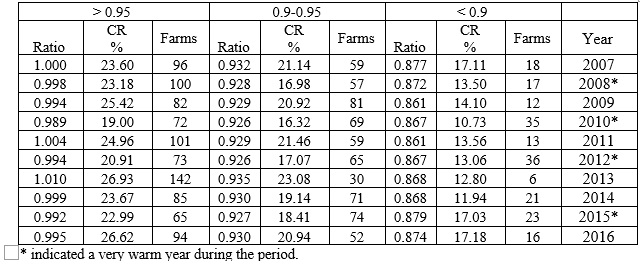
Another interesting examination that was carried out was the examination of the correlations between the various factors in the analysis. This test shows a positive correlation (r=0.447; P<0.0001) between summer/winter ratio and summer conception rates and a similar positive relationship between the amount of milk produced during the summer and the conception rates (r = 0.484; P <0.0001). In contrast, there is a negative correlation between SCC levels and milk production (r = -0.364; P <0.001) and between SCC levels and conception rates (r = -0.272; P <0.0001). These findings indicated that it is possible to achieve a high milk production together with good conception rates even in the Israeli summer.
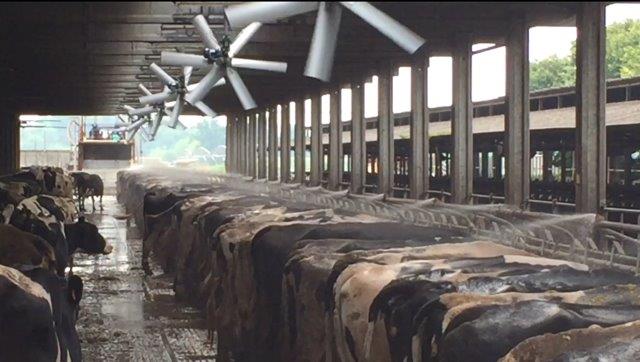
In summary:
Analysis of the data over the last ten years strengthens the fact that the heat load in a specific year has the strongest effect on both the amount of milk produced and the conception rates. It is important to note that there are differences between different geographical regions and between different dairy farms in the same geographical region.
The amount of milk produced in the summer as well as the milk ratio between summer and winter are highly correlated with the conception rates. In addition, high levels of SCC during the summer season are negatively correlated with both milk production and conception rates. The significant positive correlation between milk production and conception rates shows that it is possible to produce high amounts of milk and to achieve reasonable conception rates even during the hot summer season. These findings, as well as the large differences between the farms, indicate that proper management of the dairy farm, while maintaining a proper summer cooling management and a proper reproductive management, will both enable achieving good professional results throughout the year.

